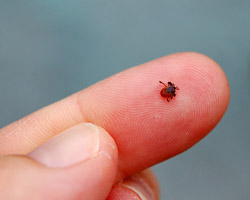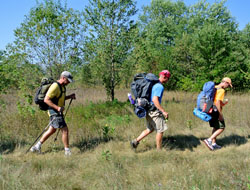Chipmunks & Ticks on North Manitou Island
Editor’s Note: This is Jim DuFresne’s third Trail Talk blog in a series from the Manitou Islands in Lake Michigan, where he was working recently on a mapping project for MichiganTrailMaps.com.
By Jim DuFresne
Chipmunks I have no fear of. These small, striped rodents are so numerous on South and Manitou Islands that they have become an overly aggressive pest to anybody setting up camp. Turn your back on them and they have been known to chew through duffel bags and packs when they get a whiff of anything that might be edible.
We were told to hang our food as if we were in bear country.
What had me truly scared heading over to North Manitou was much smaller; deer ticks. Officially known as the Black-Legged tick (Ixodes scapularis), this is the species that spreads Lyme disease. I have a friend who has suffered from Lyme disease for years and it is something I absolutely want to avoid.
I was told by a maintenance worker on South Manitou to be careful, North Manitou was having a bad tick summer. Researchers were finding large numbers of deer ticks on birds with a high percentage of them carrying the disease. On the National Park Service web site for Sleeping Bear Dunes National Lakeshore was a red flagged “Park Alert” that stated “ticks are common throughout the Lakeshore with a high population located on North Manitou Island.”
All this had me in a panic mode when I stepped off the ferry for a week of backpacking on the 15,000-acre island. This tiny insect had managed to instill more fear in me than the 900-pound brown bears I have encountered in the Alaska wilderness.
Despite being sunny every day and in the low 80s I wore a long-sleeve shirt and pants that were tucked into wool socks. As instructed I chose light colors for my clothing, stayed in the center of the trail while hiking and even packed along a small collapsible chair so I could avoid sitting on the ground or logs.
I began each morning spraying my pants and shirt with insect repellent that contained concentrations of DEET ranging from 25% to almost 100%. That was part I hated the most, dousing myself with chemicals to ward off a tiny insect.
In the evening I’d climb into my solo tent and attempted to search my body for a tick climbing up my leg or trying to burrow into my skin. I am anything but petite and in the small tent I struggled with my head lamp to search my “underarms, belly button, and back of knees” as the NPS web site advised.
It wasn’t easy and more times than not I just gave up and crawled into my sleeping bag.
Worse of all I wasn’t even sure what I was looking for. Ticks are blood-feeding parasites that are often found in tall grass and shrubs where they will wait to attach to a passing host. Physical contact is the only method of transportation for ticks as they do not jump or fly but often simply drop from their perch onto a host.
The nymph form of the deer tick is most often responsible for transmitting Lyme disease and at this stage the insect is the size of a poppy seed. Good luck finding that at night while sitting in a cramped tent with dying batteries in your flashlight.
It was a researcher that I met on the trail one day that finally eased some my fears. True, the nymph is often responsible for the disease but exposure to them usually occurs in the summer. I was there in early September. The adult form also transmits the disease but they don’t appear until October and are the size of an apple seed.
“You can clearly see them on your skin,” he said.
In the end, I realized I needed to be vigilant about deer ticks but not so overwhelmed by the fear of Lyme disease that I stop hiking and backpacking.
I needed to be outdoors, as often I can, and I realized if it meant hanging my food up at night and then checking my belly button … that’s a small price to pay to spend a night on a wilderness island.





